
Posted on 06/26/2011 6:20:25 AM PDT by Homer_J_Simpson

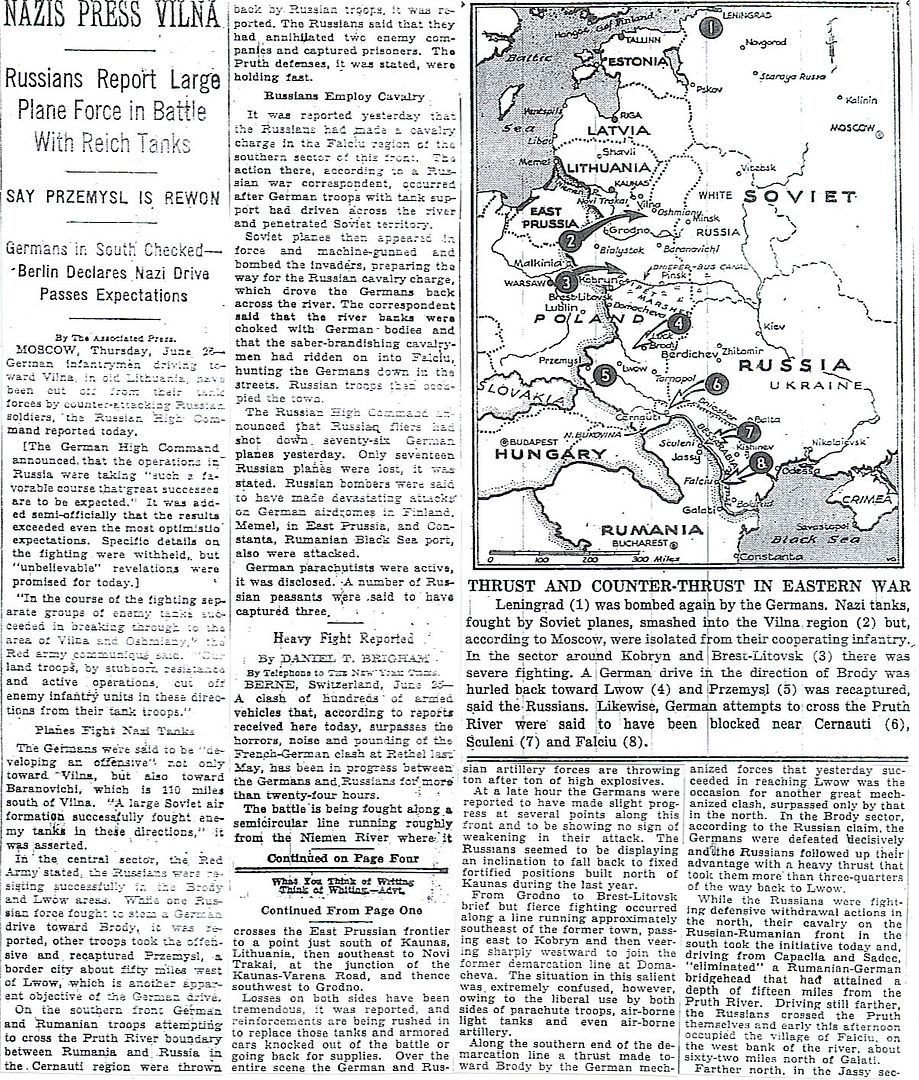
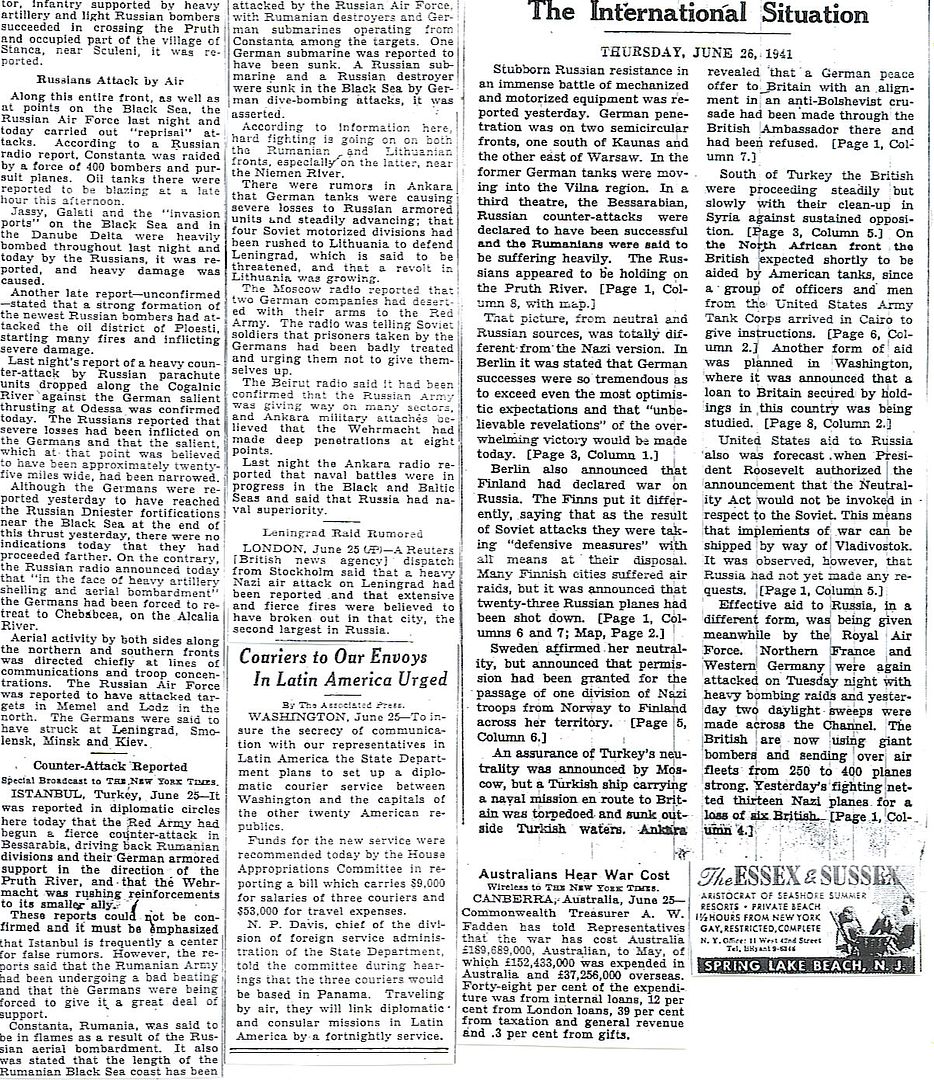
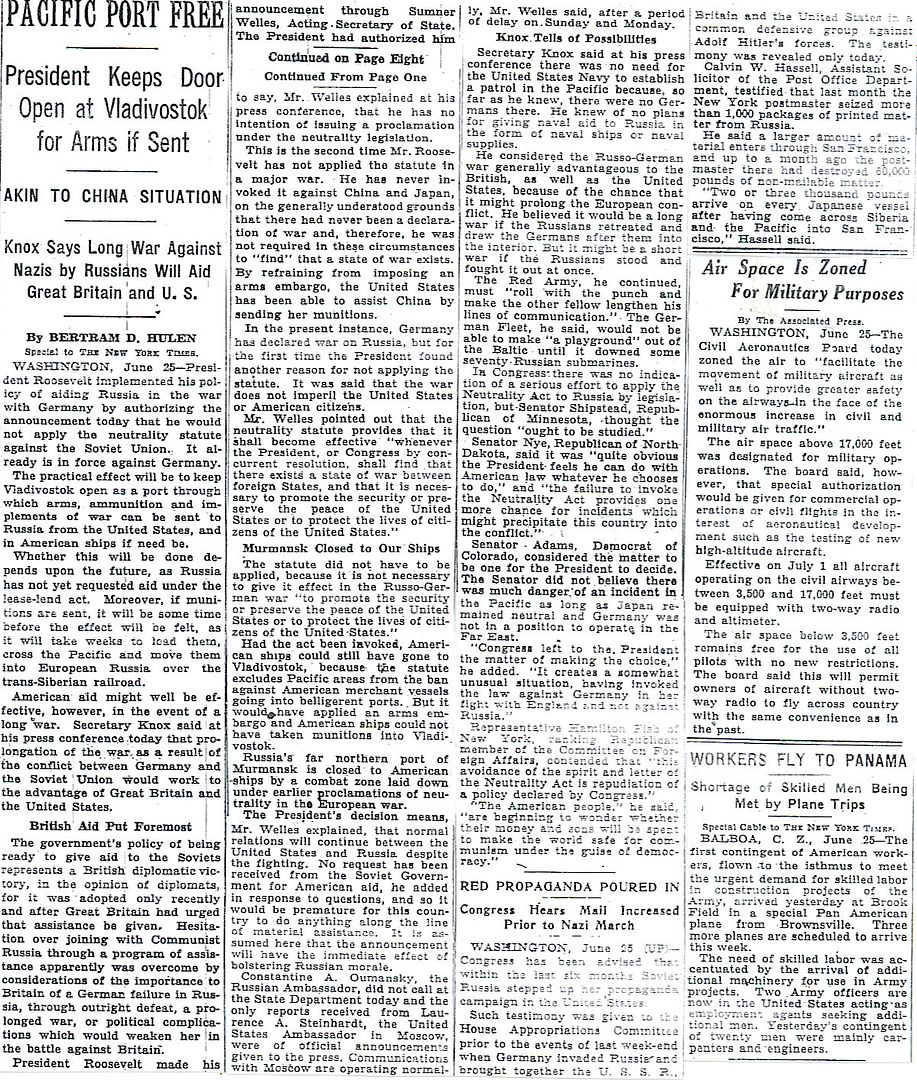
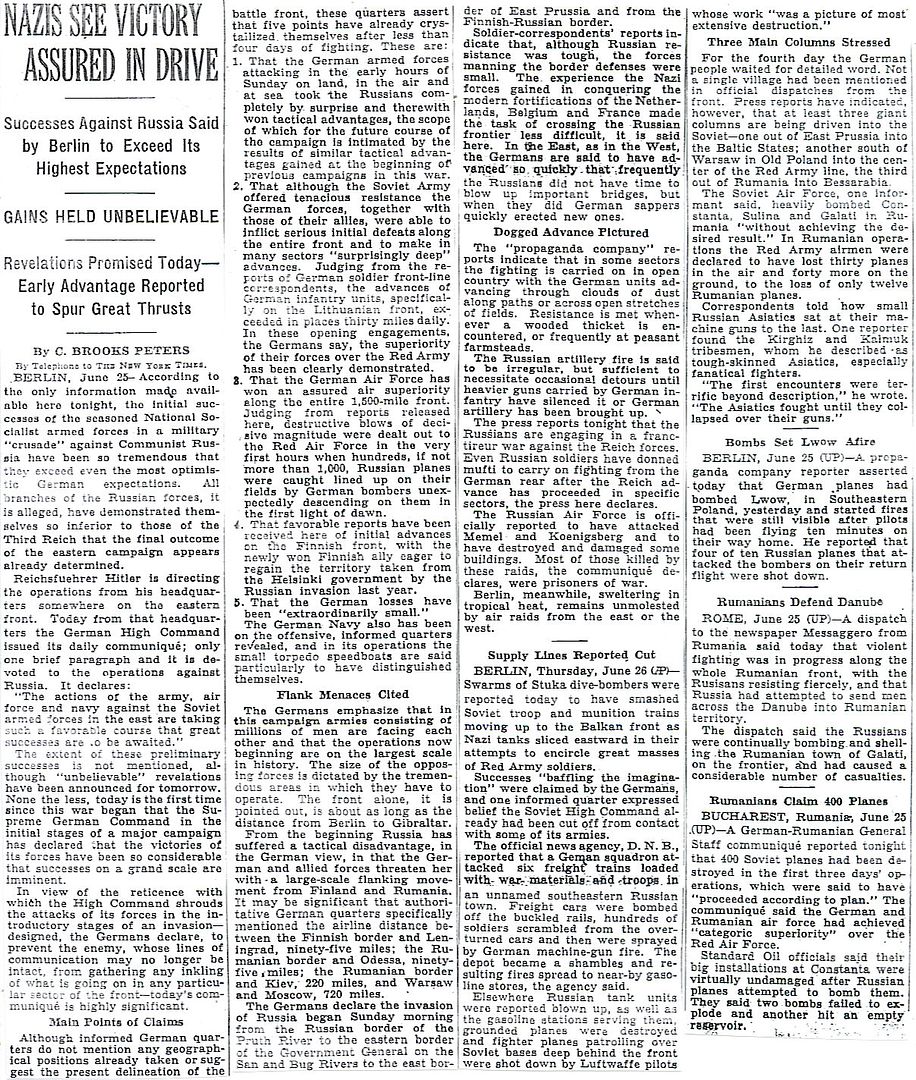

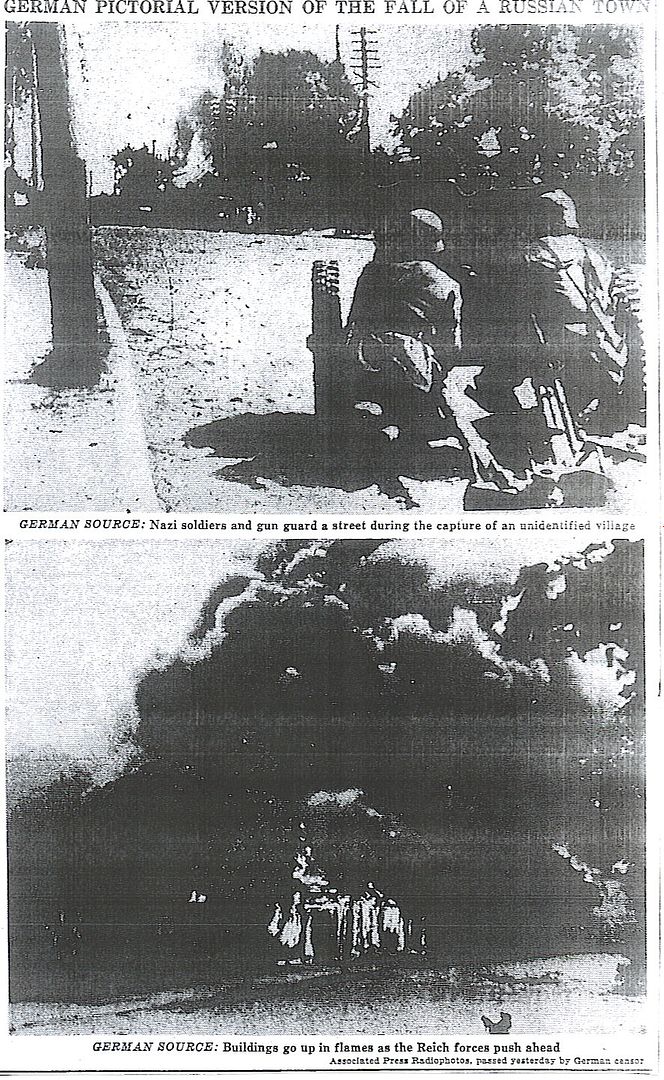
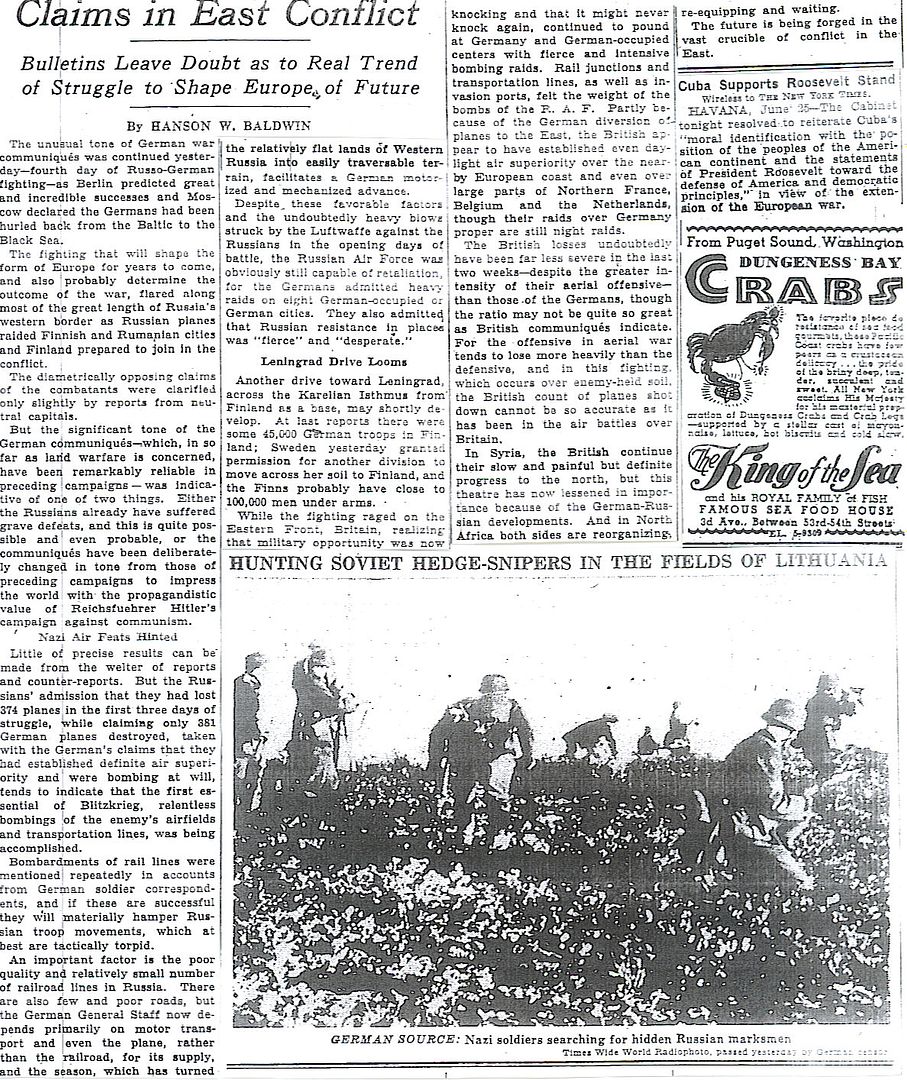
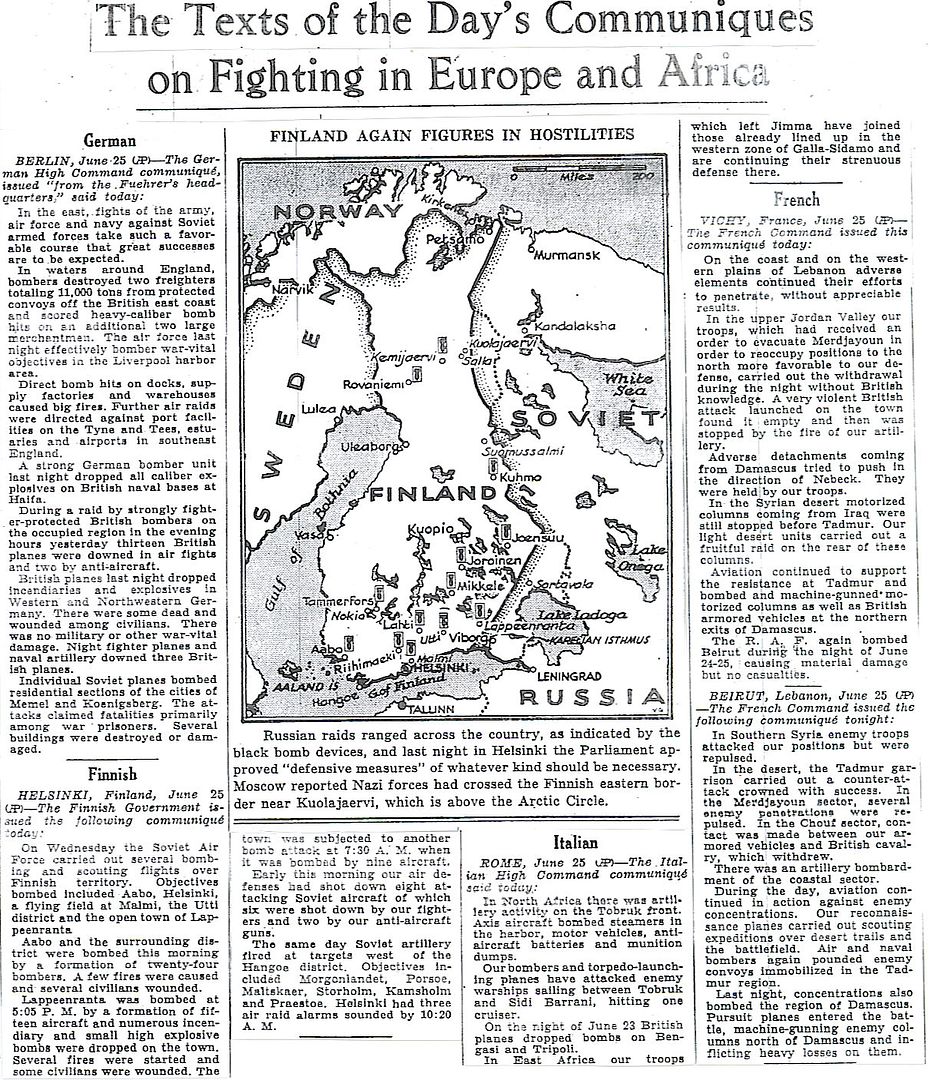
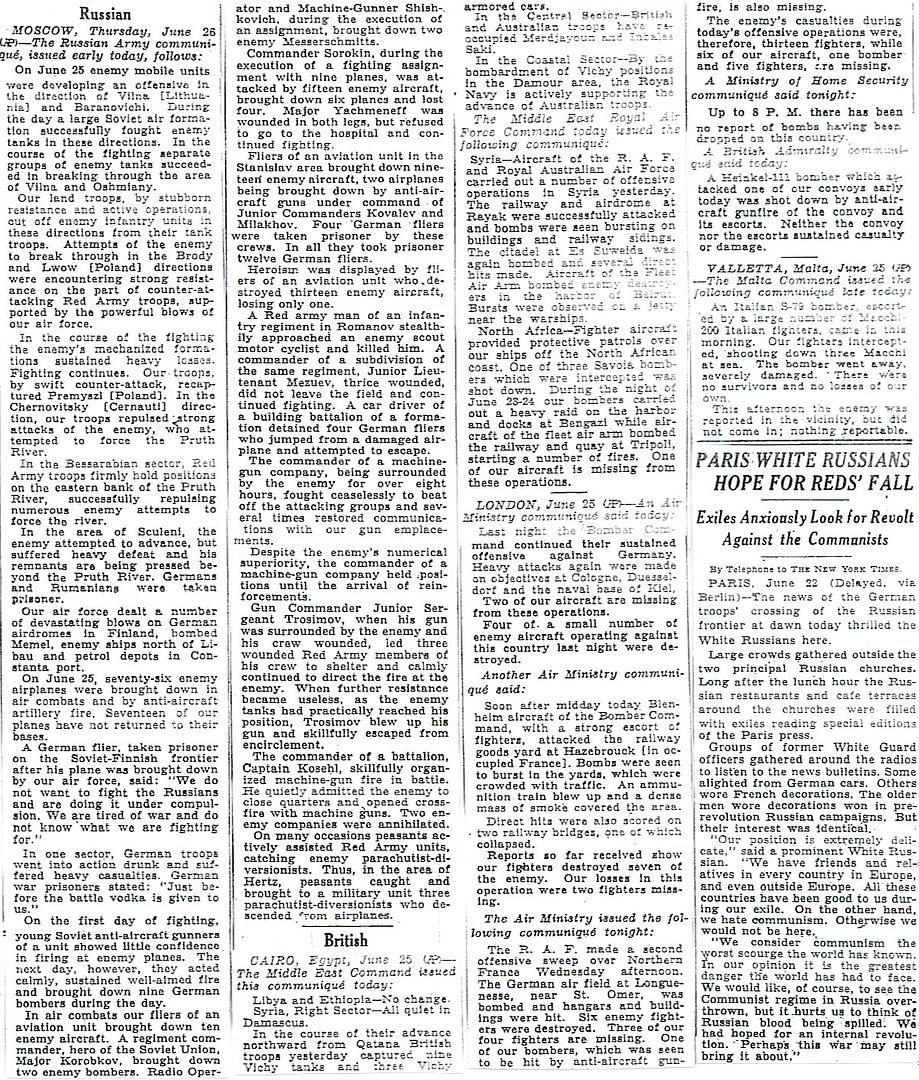
The scholar and the sword: Why military history matters
By David J. Koon
http://www.onwar.com/chrono/1941/jun41/f26jun41.htm
Germans approaching Minsk
Thursday, June 26, 1941 www.onwar.com
On the Eastern Front... In the north Daugavpils is taken in the German advance and Panzer Group 4 forces begin working to take bridgeheads over the Dvina River. In the advance of Army Group Center, forces of Panzer Group 3 are 18 miles from Minsk by midday.
From Helsinki... Finland declares war on the USSR.
In the Mediterranean... In two operations (from June 26-30th), first by Ark Royal alone and then by Ark Royal and Victorious together, 57 Hurricanes are flown off to Malta. More planes are embarked but cannot be sent because of malfunctions in the launching equipment of the carriers.
http://homepage.ntlworld.com/andrew.etherington/month/thismonth/26.htm
June 26th, 1941
UNITED KINGDOM: Minesweeper HMS Horsham laid down.
Destroyer HNLMS Evertsen (ex-HMS Scourge) laid down.
Corvette HMS Sweetbriar launched.
Minesweeping trawler HMS Eday launched.
(Dave Shirlaw)
NORTH SEA: Minesweeping trawler HMS Tranio bombed and sunk while under tow. (Dave Shirlaw)
GERMANY: Berlin: P G Wodehouse, the creator of Jeeves and Bertie Wooster, broadcast a talk to the United States from Berlin tonight. He described how he was interned after the Germans overran Le Touquet, where he had a villa: “Wodehouse, old sport, I said to myself, this begins to look like a sticky day.” Aged nearly 60, he has been released four months early from camp and brought to Berlin, where he agreed to do a series of talks. He said that internment was “quite an agreeable experience”. He is staying at the Adlon, Berlin’s best hotel.
The meat ration is cut to 14 ounces per week (double for labourers); the artificial honey ration is raised in an attempt to compensate.
U-304 laid down.
U-583, U-584 launched.
U-453, U-576 commissioned. (Dave Shirlaw)
CZECHOSLOVAKIA: Unidentified aircraft bomb the town of Kassa (Kosice) in the easternmost part of what had been Czechoslovakia. Following the Germans dissolving the Czechoslovak state in March 1939, the Hungarians occupied this area. The aircraft have also shot up a passenger train, killing 37. The Hungarians have reported the total casualties to be over 300. (Mike Yaklich)
FINLAND: Finland announces a state of war with the Soviet Union. President Risto Ryti explains in a radio broadcast the reasons that have led to the new war and states that the USSR is the aggressor. (Mikko Härmeinen, 275)
Finnish vessels Vesihiisi and Iku-Turso in minelaying operations at Estonian coast. (Dave Shirlaw)
U.S.S.R.: Hungarian Heinkel He 170s are used for the first time by the I Long-Range Reconnaissance Group in co-operation with the Luftwaffe.
The Soviet Army High Command announced:
Yesterday enemy troops pursued an offensive in the direction of Vilna and Baranovichi [White Russia]. In the course of the day sizeable Soviet aerial forces attacked the enemy units. Nevertheless a number of enemy armoured swarms succeeded in penetrating the Vilna and Oshmyany [White Russia] area. Thanks to the bitter resistance of our troops, enemy infantry units have been cut off from their armoured spearheads.
Kovno: The Wehrmacht High Command announces: [on 29 June]
...after two days of fighting the German panzer arm brought to a victorious end a massive armoured battle north of Kovno in which a number of Soviet divisions were encircled and destroyed. We captured more than 200 Soviet armoured cars, 29 of them of the heaviest type, over 150 heavy guns and hundreds of trucks.
Our armoured units and motorised divisions have pressed along both sides of the Bialystock troop pocket and reached the area around Minsk. We are about to achieve another great victory.
MOSCOW: Half an hour after Finland officially declares a state of war with the USSR, the Finnish embassy’s door is closed from the outside. Next, the guard’s weapons were taken. In the afternoon Finnish staff are told that evacuation will begin in an hour. They are allowed to take two suitcases. (Mikko Härmeinen)
Soviet submarine M-83 of the Baltic Fleet is sunk at Liepaja. (Scuttled at Libau)
M-101 is sunk by U-149 off Dago Island. (Mike Yared)(146 and 147)
ROMANIA: Major units of the Soviet Black Sea Fleet, including the cruiser VOROSHILOV and flotilla leaders (i.e. large destroyers) MOSKVA and KHARKOV, are repulsed in their attack upon the Romanian seaport of Constanta by accurate shellfire of the Royal Romanian Navy’s coastal defence batteries (Gruparea de artilerie de coasta Constanta, comprised of six batteries ranging in size from 150mm and 120mm down to 75mm), in conjunction with fire from two Romanian naval destroyers (the Regina Maria and Marasti) along with the recently installed 28cm German coastal battery “Tirpitz.” Actual hits scored by defending batteries were, few in number, and the only probable hit being on the Moskva was actually credited to either Regina Maria or Marasti — still, the Moskva was sunk as a result of this damage, with the added assistance of a mine which she struck while withdrawing from the action. (Greg Kelley)
MEDITERRANEAN SEA: Starting today HMS Ark Royal and then the HMS Ark Royal joined by HMS Victorious deliver Hurricanes to Malta. These two operations will last until the 30th of June. Some of the fighters are unable to make the launch due to equipment malfunctions.
SYRIA: Lt-Gen Lavarack orders 7 Aust Div (Maj-Gen Allen) to concentrate on coast for offensive into north Lebanon, to be reinforced by 17 Aust Bde (Brig Savige). 23 Brit Bde will relieve 7 Div units at Merdjayoun on the central axis. Maj-Gen Evetts (GOC 6 Brit Div) will command from Merdjayoun to Damascus. On the coast the Royal Navy shells French positions daily, particularly artillery positions at Abey. Nevertheless, the French artillery maintains a vigorous fire on the Australian infantry, firing concentrations of up to 200 shells at a time. Brig Plant pulls 21 Aust Bde back so as not to present an arty target, but orders vigorous patrolling in preparation for the Australian offensive to begin on 5 July. (Michael Alexander)
EGYPT: Dekheila: 805 RN Sqn, Brewster Buffalo aircraft AX813, Lt (A) Lloyd Kenneth KEITN DSC RNR of Calgary Alberta shot down and fatally wounded northwest of Sidi Barrani, Egypt, POW and later lost. (Dave Shirlaw)
CANADA: Corvette HMCS Prescott commissioned
Corvette HMCS Timmins launched Esquimalt, British Columbia.
Corvette HMCS Rosthern arrived Halifax from builder Montreal, Province of Quebec.
Minesweepers HMCS Parrsborough and Rockhampton launched. (Dave Shirlaw)
U.S.A.: In the final game of a three game series at Yankee Stadium in New York City, the St. Louis Browns send Elden Auker to the mound to face the Yankee’s Marius Russo. As Russo later put it, “I was pitching a no-hitter into the seventh inning, but nobody cared. They cared only for one thing, to see Joe (DiMaggio) get a hit.” And the hit came about thanks to some crafty managing by Yankee manager Joe McCarthy.
The Yankees were leading the Browns 3-1, but Auker was giving DiMaggio trouble again. DiMaggio was 0-for-3, and because he was scheduled to bat fourth in the bottom of the eighth inning, there was a chance he might not get a last crack at Auker. Yankee first baseman Johnny Sturm opened the eighth inning by popping out, then third baseman Red Rolfe walked and here, McCarthy made sure DiMaggio got his at-bat. He instructed the powerful right fielder Tommy Henrich - who would hit 31 homers in 1941 - to bunt, therefore avoiding a possible inning-ending double play. Henrich sacrificed successfully, and up came DiMaggio. On the first pitch, he lined a double over third base. DiMaggio’s hitting streak was now 38 games. (Jack McKillop)
Looks like you are moving into a growth industry, perfesser Cougar.
I’m all for that. Engineering is saturated.
This is great stuff! Thanks!
Without effective communications, air cover, logistical support, and sufficient modern tanks, this effort was doomed from the start. Soviet commanders encountered the standard German response to mechanized counterattacks: the leading German units gave ground quickly, luring the enemy tanks into antitank guns that always followed immediately behind the spearhead. By the end of 25 June, 6th Cavalry Corps had suffered more than 50 percent casualties (mostly from air attack), and one tank division was out of ammunition. Another division could muster only 3 tanks, 12 armored carriers, and 40 trucks.
Boldin's diversion allowed many units to escape from the Bialystok area eastward toward Minsk, but the relief was only temporary. With Third Panzer Group penetrating toward Minsk on the north flank of Soviet Western Front and Second Panzer Group advancing parallel to it in the south, Pavlov had to pull back.
On the night of 25 to 26 June, he attempted a general disengagement to withdraw behind the Shchara River at Slonim. Not all units received the order to withdraw, and most were unable to break contact. Pavlov's front had already lost much of its fuel and motor transportation, so that the troops withdrew on foot, under constant German air attack.
En route, the headquarters of Lieutenant General F.N. Remezov's 13th Army, which was in the process of deploying forward into front second echelon, was ambushed by leading German elements who captured various classified reports. With numerous bridges over the Shchara River destroyed, 10th Army was unable to get most of its units across.
On 26 June, a panicked Pavlov signaled Moscow that "up to 1,000 tanks [of Third Panzer Group] are enveloping Minsk from the northwest; . . . there is no way to oppose them."
A final effort near Slutsk by elements of 20th Mechanized Corps and 4th Airborne Corps failed to halt the advancing Germans. By 30 June, Second and Third Panzer Groups had closed their pincers around a huge pocket west of Minsk containing much of 10th, 3d, and 13th Armies. The Western Front had virtually ceased to exist as an organized force; it is not surprising that Pavlov was executed soon thereafter. His immediate successor, Colonel General A. I. Eremenko, had no time to organize the defense of the Berezina River east of Minsk, and the German armored spearheads pushed onward across the Berezina toward the Dnepr in early July.
When Titans Clashed-by David M. Glantz Jonathan M. House
Huge KV-2 found abandoned near Raseinai, Lithuania 6/26/41
German Souvenir hunters near Lvov, Poland-late June 41
German recce troops investigate Soviet tank outside Kobryn 6/27/41
On this very first day the Soviet Command showed its true face. Our troops came across a German patrol which had been cut off by the enemy earlier on. All its members were dead and gruesomely mutilated. My A.D.C. and I, who often had to pass through sectors of the front that had not been cleared of the enemy, agreed that we would never let an adversary like this capture us alive. Later on there were more than enough cases where Soviet soldiers, after throwing up their hands as if to surrender, reached for their arms as soon as our infantry came near enough, or where Soviet wounded feigned death and then fired on our troops when their backs were turned.-Field Marshal Erich Manstein-Lost Victories
Reports were beginning to emerge of possible Soviet atrocities.
Part of Soviet convoy probably destroyed by low level air attack-Mozyr road -late June.
German infantry halt to bury comrades-Lithuania 6-25
German troops search for Soviet sniper west of Lomza 6-28-41
Soviet troops captured during the first days of the war-Eastern Poland-undated.
Near the top of the list of Hitler's most serious mistakes must surely go this one: he failed to support and nurture the millions of anti-communist, or at least anti-Stalin, Soviet peoples.
Instead, he treated them all like serfs and slaves to be brutalized however he felt necessary.
The natural result was, those people soon figured out the Germans did not come to liberate them, but to murder & oppress them even more than Stalin had.
Good question, it may be a BT-7 but I'm not really sure.

I am missing something here. The caption says it is a KV-2. That's not the answer?
I am missing something here. The caption says it is a KV-2. That's not the answer?
It's labeled KV-2, and looks like a KV-2....
I’m looking at the first photo in post #12. The first one in post #11 is definitely is a KV-1.
Excuse my fast fingers. I meant KV-2.
Disclaimer: Opinions posted on Free Republic are those of the individual posters and do not necessarily represent the opinion of Free Republic or its management. All materials posted herein are protected by copyright law and the exemption for fair use of copyrighted works.